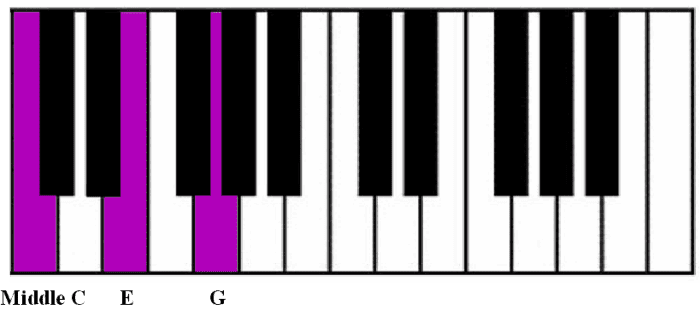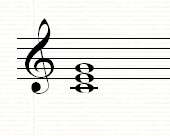Easy Way to Learn Inversions and Cadences
JohnMello is a writer, composer, musician, and author of books for children and adults.
When the term "chords" is used in relation to piano music, it usually involves the traditional triad. Triads are three-note chords that serve as the basis for most popular music and a great deal of the classical music you hear much of the time.
The word "triad" means a group of three notes that can be stacked in thirds, usually containing the root, third and fifth degrees of the scale. For example, the C major triad contains the notes C, E and G, the first, third and fifth degrees of the C major scale. The distance between the first and third, and between the third and fifth, is an interval of a third.
Here's what the basic C major triad in root position looks like, starting on the note middle C.

The C triad in root position
JM
Here's what that chord looks like when played on your piano or keyboard.

The C chord in root position uses the notes C, E and G
JM
Making Chord Inversions
When we speak about chord inversions, we're talking about rearranging the order of the notes within the chord. When C is the bottom note of the chord we say it is in root position. C is the root of the chord (i.e. the C chord) so that makes perfect sense.
A triad or three-note chord can have two inversions. When the middle note is on the bottom of the chord, we say it's in first inversion, and when the top note of the three is on the bottom, we say it's in second inversion. Here's what those chords look like on the score:

The C chord in root position (bottom note C)
JM

The C chord in 1st inversion (bottom note E)
JM

The C chord in 2nd inversion (bottom note G)
JM
Here's what those chords look like on your piano or keyboard.

Root position
JM

1st inversion
JM
Scroll to Continue
Read More From Spinditty

2nd inversion
JM
Chord Inversion Basics
Why We Use Chord Inversions
One of the main reasons for using chord inversions is to enable smooth movement from one chord to another. For example, imagine a piece of music moving from the I chord to the IV chord to the V chord and back to the I chord, as it might do at a cadence point. If we played or wrote that progression using only chords in root position, it would sound jumpy and disconnected.

Moving through the chords C, F, G and C (I, IV, V, I) in root positions
JM
We can move through exactly the same chords, making use of inversions, in a much smoother manner. This is particularly useful in vocal music when you want the singers to be able to move from note to note without too much difficulty.

Moving through the chord progression using inversions: C root position, F 2nd inversion, G 1st inversion, C root position again
JM
There are occasions when inversions aren't required. Sometimes you want the chords to be more rhythmical and percussive, such as in rock music. In these cases, it's perfectly justifiable to use chords in root position only, like this.

Root position chords used in a percussive, rhythmic way
JM
Using Inversions to Make Music
The other thing you get with chord inversions is variety and the potential to move around the keyboard. If we stick with just the C, F, and G chords (the I, IV and V) it's surprising how complex a chord progression we can make. Here's an example of the chords moving smoothly up and down the keyboard.

A typical hymn-like progression moving smoothly through the three basic triads
JM
Chord inversions work exactly the same way for every chord you come across. If it's a four-note chord, such as a seventh chord, then there'll be four possibilities: root position, 1st inversion, 2nd inversion, and 3rd inversion. In each case, the bottom note will change.
Also, remember that chord inversions affect the entire chord as it's played on the piano or keyboard. Inversions are designated by the name of the note at the bottom of the chord. That means that if you play a C chord on the piano with the note E in the bass, that chord will be said to be in 1st inversion. Likewise, if you play a C7 chord with the note B flat in the bass (the 7th note of the chord) then that chord will be said to be in 3rd inversion:

C chord in 1st inversion (E is the lowest note)
JM

C7 chord in 3rd inversion (B flat is the lowest note)
JM
The Power of Chord Inversions
Here's another example to show you just how useful chord inversions can be. Whatever your musical tastes, chances are you've heard of the composer Handel, possibly best known for the Hallelujah Chorus from the oratorio Messiah. Another of his most popular works is the Water Music, from which the following is a brief excerpt. I've written in the chord positions.

Believe it or not, this excerpt from Handel's Water Music uses only 2 chords!
JM
Quiz
For each question, choose the best answer. The answer key is below.
- What's another name for a 3-note chord?
- Sally
- Matilda
- Triad
- How many inversions can be created using a normal triad?
- 1
- 2
- 3
- Playing a G minor chord with the note B flat as the lowest note means:
- You're in root position
- You're in a weak position
- You're in 1st inversion
- 4-note chords can be in the following positions:
- Root, 1st inversion, 2nd inversion and 3rd inversion
- Root, 1st inversion and 3rd inversion
- 1st inversion, 2nd inversion and 3rd inversion
- What do chord inversions produce?
- Happy sounds
- Leaps and jumps
- Smooth movement from one chord to another
- A chord is in root position when:
- It's played one note at a time
- The lowest note played is the root of the chord
- Some of the notes are missing
Answer Key
- Triad
- 2
- You're in 1st inversion
- Root, 1st inversion, 2nd inversion and 3rd inversion
- Smooth movement from one chord to another
- The lowest note played is the root of the chord
You can hear all of the music included in this article by checking out the video at the very top of the page. Make sure you have a go at the quiz below, too, to find out how much you've learned.
Other Chord-Related Articles
- Broken Chords Accompaniment on Piano
Accompanying on the piano can be as simple or as complicated as you want it to be. Here's one way to create a back-and-forth style of accompaniment that's easy to master. - How to Harmonize a Tune on the Piano or Keyboard
Harmony can be a difficult concept to understand. This exercise shows you an easy way to get to grips with it so you can harmonize tunes on the piano all by yourself. - The Function of Cadences in Music
What are cadences in music and why do we need them? Find out their function and how they work by reading the full article.
Questions & Answers
Question: How can I play difficult music better?
Answer: Practice is the key to doing anything better, and it's the same with music. The harder it is, the more you have to work at it. One way to make it easier on yourself is to practice in small sections, get them right, and then put it all together.
Source: https://spinditty.com/learning/How-to-Create-Chords-and-Inversions-on-the-Piano
0 Response to "Easy Way to Learn Inversions and Cadences"
Publicar un comentario